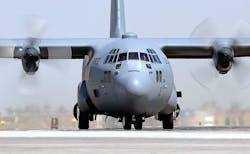SRC to install radar warning receiver aboard C-130 aircraft for airborne electronic warfare (EW)
Officials of the Air Force Life Cycle Management Center at Robins Air Force Base, Ga., are awarding an $11 million contract to SRC to put the radar warning receiver aboard C-130H aircraft.
The ALR-69A all-digital radar warning receiver is designed to enhance aircrew survivability and situational awareness by warning the crew of the presence of enemy search and missile-targeting radar.
The system can suppress enemy air defenses, provides enhanced spectral and spatial coverage for high-sensitivity detection in dense signal environments, and single-ship geolocation.
The ALR-69A(V) uses advanced broadband digital receiver technology and an open architecture design, which enables cross-platform commonality, improved spectral and spatial coverage, and integration with other electronic countermeasures or radar systems.
The ALR-69A(V) design relies on commercial off-the-shelf (COTS) components to enable expansion or upgrades. The 16-channel broadband receiver can be reconfigured to support future applications, and as data converter technology continues to improve, users can boost response time and dynamic range by replacing a digital circuit card.
Extra, pre-wired card slots enable interfaces to any electronic countermeasure or radar system, Raytheon officials say.
Without any hardware modifications, the ALR-69A(V) can offer aircrews single-ship geolocation capability to help determine the direction of the arrival of the threat signals.
This added capability enables the ALR-69A to assist with targeting solutions while continuing to identify threats in dense signal environments.
On this contract SRC experts will do the work in Warner Robins, Ga., and should be finished by October 2022. For more information contact Scientific Research Corp. online at www.scires.com, or the Air Force Life Cycle Management Center at www.robins.af.mil/Units/AFLCMC.
Ready to make a purchase? Search the Military & Aerospace Electronics Buyer's Guide for companies, new products, press releases, and videos

